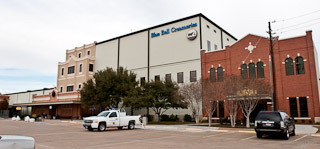
Blue Bell, founded in 1907, is only available in twenty states, so I was surprised to learn they are the 3rd largest ice cream maker in terms of sales (after Dreyer's and Breyer's). On the day we visited, there were over 800 factory workers on site, but the place is so large (the Brehnam facility makes most of Blue Bell's ice cream) that only a few show up in our photographs.
 The visitor's center was being renovated when we were there, but renovations should have been completed in March 2012.
The visitor's center was being renovated when we were there, but renovations should have been completed in March 2012.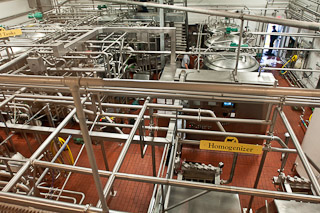 Ice cream production all begins with milk. The milk is delivered to the facility and temporarily stored outside (in giant enclosed containers). It is here that the milk is tested, evaporated, and split before being brought in for mixing, homogenization, and pasteurization.
Ice cream production all begins with milk. The milk is delivered to the facility and temporarily stored outside (in giant enclosed containers). It is here that the milk is tested, evaporated, and split before being brought in for mixing, homogenization, and pasteurization.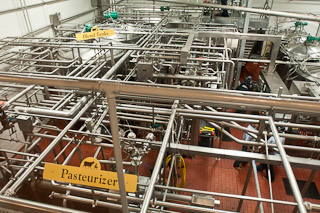 |
| Pasteurizing and homogenization occur in this first stage |
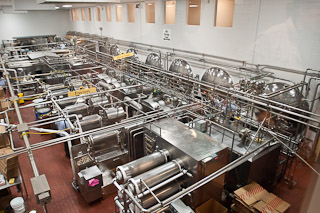 The ice cream bases (there are different ones for different ice cream flavors) are mixed with flavoring agents before being pumped through chillers that rapidly bring the temperature down to 40°F (around the consistency of a malt shake).
The ice cream bases (there are different ones for different ice cream flavors) are mixed with flavoring agents before being pumped through chillers that rapidly bring the temperature down to 40°F (around the consistency of a malt shake).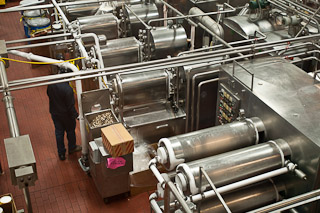 At this point, mixins are added. In the hopper, you can see marshmallow and chocolate chunks for making Rocky Mountain Road (a new flavor introduced to celebrate Blue Bell's introduction to the Colorado market) which the machine will mix into the slushy ice cream.
At this point, mixins are added. In the hopper, you can see marshmallow and chocolate chunks for making Rocky Mountain Road (a new flavor introduced to celebrate Blue Bell's introduction to the Colorado market) which the machine will mix into the slushy ice cream.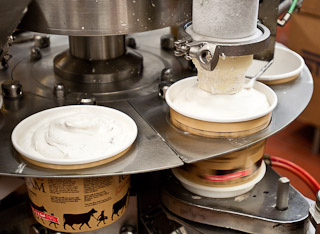 The chilled ice cream is then pumped over to the packaging station which positions an empty container under the nozzle and spins the container while ice cream is deposited into it. The spinning action throws the ice cream out toward the circumference of the carton preventing air pockets from being trapped in the container.
The chilled ice cream is then pumped over to the packaging station which positions an empty container under the nozzle and spins the container while ice cream is deposited into it. The spinning action throws the ice cream out toward the circumference of the carton preventing air pockets from being trapped in the container.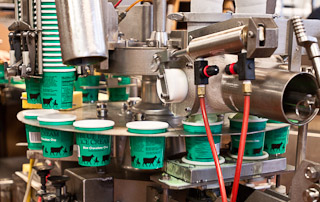 Here's another view of a machine showing how the cartons are loaded and then rotated under the ice cream dispensing nozzles to be filled.
Here's another view of a machine showing how the cartons are loaded and then rotated under the ice cream dispensing nozzles to be filled.The full ice cream cartons are then rotated out of the way of the ice cream dispensers to the lid stage. The machine presses the lids into place before the ice cream carton is lifted out of its hole and pushed onto a conveyer belt.
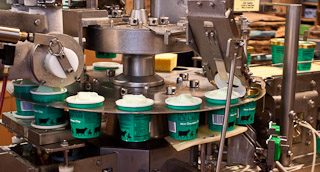
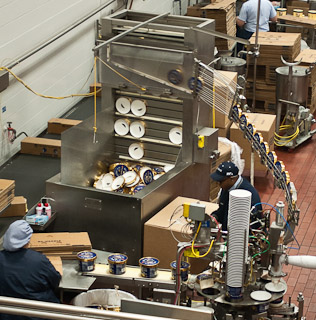 We were fascinated by the lid sorting part of the packaging machine. Lids are thrown into a hopper which has an elevator with tiny shelves. Then the lids are pushed against the elevator and the shelves catch hold of the lids and lift them. The shelf is so small that unless the lid is facing open side out (and therefore leaning against the elevator) it will fall off the shelf. The lids, now oriented in the same direction, are then flipped onto a narrow ramp (with railings to keep the lids from falling off) to be fed into the packaging machine.
We were fascinated by the lid sorting part of the packaging machine. Lids are thrown into a hopper which has an elevator with tiny shelves. Then the lids are pushed against the elevator and the shelves catch hold of the lids and lift them. The shelf is so small that unless the lid is facing open side out (and therefore leaning against the elevator) it will fall off the shelf. The lids, now oriented in the same direction, are then flipped onto a narrow ramp (with railings to keep the lids from falling off) to be fed into the packaging machine.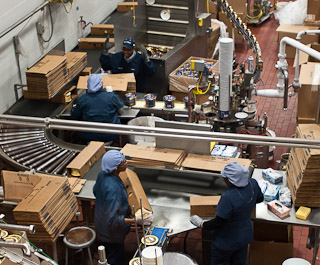 Factory workers then take the individual cartons, box them (three at a time), and then drop them upside down onto the conveyer belt that transports the ice cream to the freezer. The ice cream is placed upside down to be frozen so that a tight seal is formed with the lid. The ice cream is held in the blast freezer for six hours and is chilled to -20°F.
Factory workers then take the individual cartons, box them (three at a time), and then drop them upside down onto the conveyer belt that transports the ice cream to the freezer. The ice cream is placed upside down to be frozen so that a tight seal is formed with the lid. The ice cream is held in the blast freezer for six hours and is chilled to -20°F.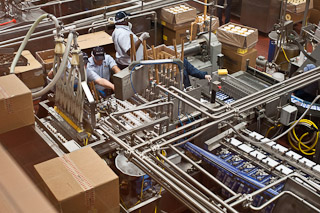 Here is an ice cream cone filling machine. Cones are placed onto a conveyer belt in a grid of holes designed to keep them upright for filling. Once the cones are filled, the conveyer deposits them onto another conveyer belt below which takes them back the other direction where they are enveloped in two sheets of plastic to form a bag. They are then transported off the line to be packed into boxes and deep frozen.
Here is an ice cream cone filling machine. Cones are placed onto a conveyer belt in a grid of holes designed to keep them upright for filling. Once the cones are filled, the conveyer deposits them onto another conveyer belt below which takes them back the other direction where they are enveloped in two sheets of plastic to form a bag. They are then transported off the line to be packed into boxes and deep frozen.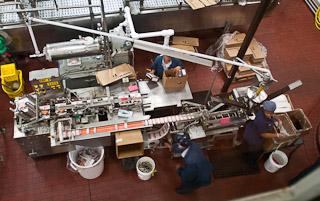 Tina and I spent a lot of time mesmerized by the operation of the ice cream sandwich machines.
Tina and I spent a lot of time mesmerized by the operation of the ice cream sandwich machines.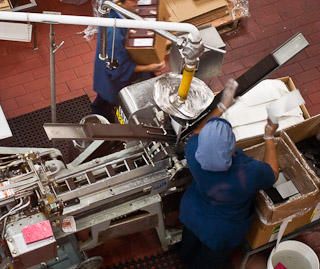 Wafers are hand loaded into chutes on two sides of the machine.
Wafers are hand loaded into chutes on two sides of the machine.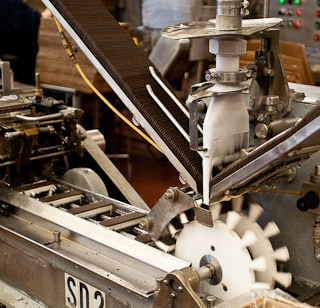 The machine holds these wafers vertically but apart. Between the two wafers is an ice cream dispensing apparatus with a pipe filled with ice cream (of a denser, thicker, and more solid consistency achieved by using a different recipe than their regular ice cream) and a device (two moving plates) that keeps the wafers divided from the ice cream as it extrudes. The dispensing pipe deposits a rectangular column of ice cream between the wafers and the plates lift allowing the wafers to slide down and press against the ice cream column to form the sandwich (oriented vertically). A large plastic gear then rotates taking that sandwich out of the way so the ice cream dispenser can descend and another sandwich can be made. After a few rotations, the ice cream sandwich has rotated 90° and is then dropped onto a conveyer belt where it is slid into a packaging machine which "folds" a wrapper around the ice cream sandwich as the sandwich is pressed into the sheet by the conveyer.
The machine holds these wafers vertically but apart. Between the two wafers is an ice cream dispensing apparatus with a pipe filled with ice cream (of a denser, thicker, and more solid consistency achieved by using a different recipe than their regular ice cream) and a device (two moving plates) that keeps the wafers divided from the ice cream as it extrudes. The dispensing pipe deposits a rectangular column of ice cream between the wafers and the plates lift allowing the wafers to slide down and press against the ice cream column to form the sandwich (oriented vertically). A large plastic gear then rotates taking that sandwich out of the way so the ice cream dispenser can descend and another sandwich can be made. After a few rotations, the ice cream sandwich has rotated 90° and is then dropped onto a conveyer belt where it is slid into a packaging machine which "folds" a wrapper around the ice cream sandwich as the sandwich is pressed into the sheet by the conveyer.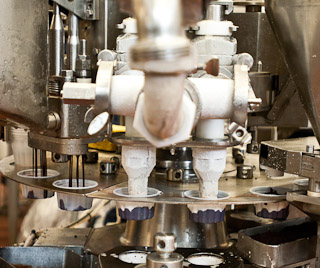 Here, another machine fills small ice cream sundaes similar to the kind you would find in a school cafeteria. Chocolate syrup is squirted into the bottoms of the cups followed by the ice cream and paper lid. Many of the machines work on the same general design: empty containers are loaded into slots at the start and the container is rotated though a series of stages which fill and complete the packaging of the product before a complete rotation has been performed.
Here, another machine fills small ice cream sundaes similar to the kind you would find in a school cafeteria. Chocolate syrup is squirted into the bottoms of the cups followed by the ice cream and paper lid. Many of the machines work on the same general design: empty containers are loaded into slots at the start and the container is rotated though a series of stages which fill and complete the packaging of the product before a complete rotation has been performed.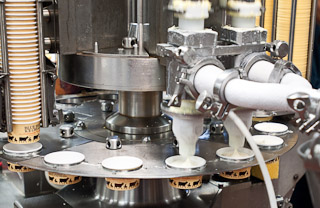 This minicup machine demonstrates this the best. Empty containers are fed, two at a time, into slots in the machine from above. The cups are rotated under the ice cream dispenser where they are filled.
This minicup machine demonstrates this the best. Empty containers are fed, two at a time, into slots in the machine from above. The cups are rotated under the ice cream dispenser where they are filled. One partial rotation takes the cups out of the way of the dispenser and another brings them to the machine which presses the plastic lids into place.
One partial rotation takes the cups out of the way of the dispenser and another brings them to the machine which presses the plastic lids into place.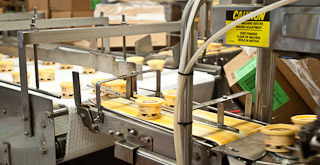 Two more partial rotations brings the cups to a device which lifts them out of their slots and into the line of a pusher that places them onto a conveyer belt which whisks them to a factory worker for packing into a box and taking to the blast freezer. Because each partial rotation happens about once a second, each machine can produce 120 cups per minute.
Two more partial rotations brings the cups to a device which lifts them out of their slots and into the line of a pusher that places them onto a conveyer belt which whisks them to a factory worker for packing into a box and taking to the blast freezer. Because each partial rotation happens about once a second, each machine can produce 120 cups per minute.Our guide grabbed a few cups right off the line for us to taste before concluding our tour. There's definitely something special about eating fresh ice cream that hasn't quite been frozen to it's final consistency. The warmer temperatures brings out a stronger vanilla note and makes it also taste sweeter while the texture is perfectly silky since no ice crystals have had any time to form within the ice cream. It's probably the perfect soft serve.
Related Articles
